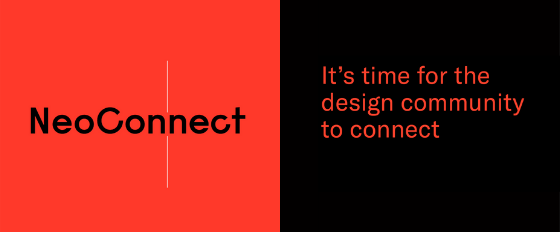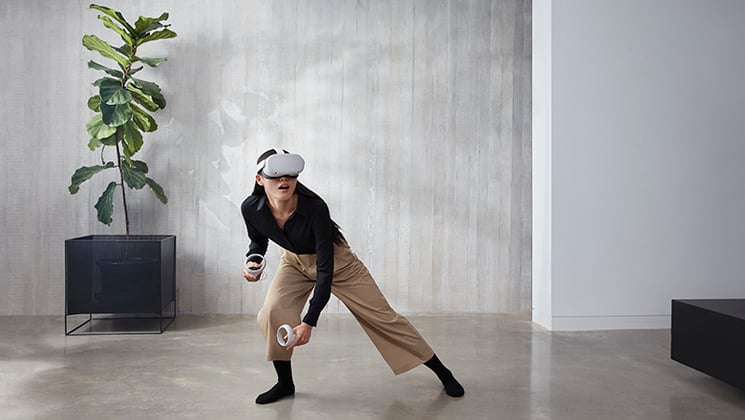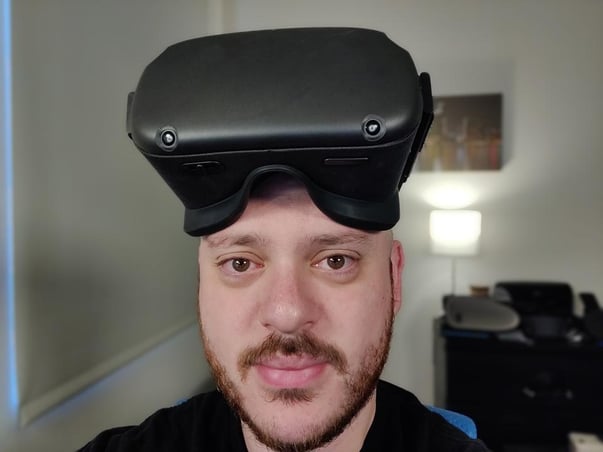2020 - what a year it has been. Perhaps you’re in the camp where the start of December feels slightly jarring since all the months feel like they’ve meldedtogether like we’re just experiencing an extra long month of March. Or perhaps this year has dragged on and you can’t wait for the dawn of a new year. One thing’s for sure though: we’re all looking forward to the fresh start that we’re hoping 2021 will bring. However, before we run too fast into the new year, it’s important to take some time to take a step back and see how far we have come.
It has been an incredibly challenging year to say the least. However, there have been countless feats, triumphs and businesses leading the charge in innovation and overcoming their current circumstances with the use of technology, specifically immersive technologies.
Today, we’ll be highlighting 4 of the biggest trends and releases that have come out of this year as well as celebrating how VR was able to provide support to many industries.
1. Virtual Events
Perhaps one of the biggest (and for some most painful) transition of this year was the need to meet virtually for events. Tradeshows, events, conferences, concerts, everything had to convert to a completely remote experience, and for good reason. The COVID-19 virus reached the shores of North America during the middle of March early April right at the beginning of conference season. Huge events like Google’s I/O, Facebook’s F8 and the annual NeoCon conference all shifted to an online format. This gave participants an endless stream of webinars to join, panels with industry leaders sharing useful forward-thinking insight, and a platform to connect and learn from each other despite geography.

NeoConnect was NeoCon's 2020 virtual event, providing a place for professionals to learn and connect with one another.
While many conferences have had to go back to the drawing board and get started building the necessary virtual infrastructure, this year has given (perhaps forced) everyone to give virtual formats a good try. Although this format is still currently out of necessity, this global pandemic fast-tracked what was already the future of Enterprise conferences. And while there were a number of colossal barriers like getting enough content lined up, organizing speakers and other assets due to timing, moving forward, virtual events can and will only get better. A number of conferences like SIGGRAPH 2021 have already announced that their 2021 conferences will continue in a virtual format. And with the lessons learned from this year’s round of online events, next year’s virtual conferences will sure to be nothing short of impressive.
2. Oculus Quest 2 Release
In mid-September, the VR industry experienced yet another revolutionary VR headset release - the Oculus Quest 2. Last year the first generation Quest made huge waves in the VR industry, promising to provide an exceptional immersive experience in a standalone device.

The Quest 2 is currently one of the most powerful and affordable standalone headsets currently available. Image Courtsey: Facebook
Previously, the Oculus Go was the only standalone VR headset that could deliver a high-quality wireless experience at a price that was affordable for most businesses. However, when Oculus announced that they were designing, creating and will be releasing a headset that would combine the extraordinary quality you would get with their tethered solution - the Rift S - and the mobility of the Oculus Go. The release was a huge success, providing another solution for professionals looking for a device that would give them greater direct interaction within their VR space. Now, Oculus has done it again with their latest iteration of the Quest.
Aside from Oculus making the headset 10% lighter than the first Quest, the Quest 2 has better resolution, refresh rate, and costs approximately $100USD less. With the starting price of $299USD, the Quest 2 is an extremely affordable yet powerful piece of VR hardware with an overall improvement in the performance of the headset and quality of the immersive experience. Plus, you can continue enjoying the best part about standalone headsets - you don’t need to worry about setting up or purchasing extraneous hardware, making it technology you can truly grab-and-go.
3. Increase in Remote/Mobile Technologies
With countries, states and cities all observing a form of quarantine, lockdown or strict social distancing, all businesses have had to transition into a time of remote work. Professionals were ushered into a time of working from home indefinitely, causing companies to start researching remote tools and creating processes to support their employees.
Online applications like Google Cloud and its Microsoft-inspired Docs, Spreadsheet, and Slides applications have become instrumental in providing a platform for people to work and most importantly collaborate anywhere at any time. Virtual conferencing applications like Zoom became almost an overnight success, going from just under 56,000 global downloads in a day to 2.13 million, beating their 2.04 million downloads just from the day before.
Even with Yulio, we were able to support and partner with numerous businesses to provide a way to present their designs and meet with their clients remotely. One project that we are proud to be a part of was The Inaugural Exhibition VR art gallery by Fergus McCaffrey. Due to the restrictions of the pandemic, many galleries were forces to close their doors, barring art enthusiasts from being able to visit their showrooms. With a VR experience, artists and curators are still able to showcase their stunning artwork and give gallerygoers the ability to wander virtually and to get as close to the real thing from the comfort of their own home. While many cities are starting to slowly loosen their COVID-19 regulations, VR experiences will continue to be a useful and impressive asset for businesses to send to clients in the new year.
Here is the stunning The Inaugural Exhibition VR project - click here or the picture to explore it today!
4. VR in Healthcare
Healthcare workers and the industry as a whole were perhaps by far those who were most affected by the pandemic. Given the world’s current global pandemic, the healthcare industry has been our shining beacon of hope to not just treat the sick but to also find a cure that could hopefully help all of us back to “normal”. However, with workers also getting sick from administering care and hospitals and clinics becoming short-staffed, the industry increasingly needed remote yet effective advanced solutions that could aid in the reskilling of millions in the workforce.
To say that there is demand for VR in healthcare would be an understatement. The VR market for healthcare in just the United States alone is currently estimated worth $101.4 million in just 2020 alone, projecting to reach $2.2 billion by 2027. The immersive capabilities of VR are what sets it apart from other modes of training. And especially with this COVID-19 virus, any unclarity or mistakes will be far too costly.
VR has already been proven to be useful in healthcare with its “hands-on” training in anatomy and other critical care verticals like surgery. However, especially in this season, VR has been able to help healthcare workers visualize, understand and practice the correct steps for putting on Personal Protective Equipment (PPE) and support patients in rehabilitation post-COVID-19. I particularly enjoyed reading Anshel Sag, contributor at Forbes, and his personal experience with using VR - specifically the Supernatural VR exercise app - to aid in his recovery. To add to it, VR has been a helpful tool for the elderly population, who are at higher risk of experiencing complications if infected with COVID-19. VR gives them a way to still “go out” and experience the world without putting themselves in unnecessary danger.

By using VR exercise app Supernatural VR, Anshel Sag has now made a full recovery from COVID-19. Image Retrieved: Forbes
These are just a few examples of how professionals and healthcare workers were able to take VR technology and innovate it to fit their needs. And like the findings from Globe News Wire, VR in healthcare won’t be going anywhere soon.
2020 VR RoundUp - A Year of Challenges, Opportunity, and Growth
Although it has been a very long year for all of us, the VR industry was able to play a large role in supporting many sectors in Enterprise. From providing a platform for businesses to meet, discuss, and collaborate to becoming an essential tool for one of the most vital industries, it’s been a fantastic year seeing the new uses for this advanced immersive technology as well as increased usage for early adopters. In just a few weeks, we’ll be exploring what’s in store for VR in 2021 and why you should get excited for another year of VR.
We hope you enjoyed looking back with us on this year’s 2020 VR roundup!
Don’t forget to stay tuned for our post on VR in 2021 - follow us on Facebook, Twitter or Linkedin to make sure you get notified when the post comes out. And as always, if you’re interested in learning more about VR for business or our Yulio platform, feel free to reach out to our team to schedule a demo - we would love to chat with you.




%20(1).jpg?width=245&height=150&name=neonbrand-mlZzMow-CQw-unsplash%20(1)%20(1).jpg)
